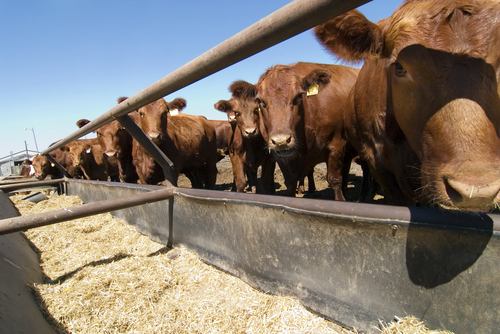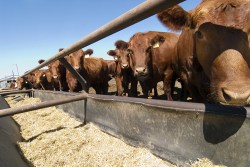The debate over the use of antibiotics in farming might have finally hit the mainstream. This summer, ABC’s World News Tonight investigated the link between antibiotic use in industrially farmed chicken and the growing scourge of antibiotic-resistant urinary tract infections in women. Meanwhile, Consumers Union published a survey in which 60 percent of respondents reported that they’d pay more at the supermarket for meat that was free of antibiotics.
So, I thought it might be a good time to check in with the latest news on antibiotics in agriculture. Let’s round up those antibiotic-dosed dogies!
Antibiotics in ethanol — and thus your meat — not coming out any time soon
Back in the spring, I wrote about a report produced by the Institute for Agriculture and Trade Policy that accused pharmaceutical companies of illegally marketing antibiotics to the ethanol industry. IATP produced evidence that the Food and Drug Administration knew of this practice, yet did nothing to stop it.
Ethanol producers add antibiotics to the grains to control “infections” during the fermentation process. And, unbeknownst to many eaters, 30 million tons of ethanol byproducts, or “distillers grains,” are fed to livestock here and abroad every year. (As an industrial byproduct, distillers grains are cheap and abundant). But those spent grains also contain enough antibiotic residue to contribute — at least in some cases — to a rise in antibiotic resistance in the animals to which they’re fed.
I received a vague denial from the FDA when I asked them to assess the legality of this practice. But the inquiries (thankfully) did not stop with your intrepid reporter. Reps. Louise Slaughter (D-N.Y.) and Edward Markey (D-Mass.) sent a letter to the FDA asking for a bit of an explanation as well. Earlier this month, the agency responded [PDF] — not by doing further investigations or changing their policy, but by writing a letter. IATP’s blog summarized the response:
… the FDA states it has not recognized any ethanol antibiotics as safe [in ethanol production], nor has it completed a review of the food additive petitions that have been submitted by the manufacturers.
In addition, the letter includes “a clearly stated acknowledgement … that the agency has not carried out sufficient safety reviews to properly assess the multiple risks posed by antibiotic use in ethanol.”
What the letter does not include is a statement that the FDA will crack down on the pharmaceutical companies who are marketing the antibiotics to ethanol producers. It’s worth noting that antibiotics are not required to make ethanol; there are other ways to keep bugs out of the factories. Antibiotics are just an easy (some might say lazy) solution. But this steady stream of medically important antibiotics flowing into farm animals continues to create problems for people.
Antibiotic resistance: It goes way beyond the farm
Several new studies point to the growing problem of antibiotic resistance as well as the dominant role played by agriculture. A study that looked at the prevalence of “resistance genes” for two antibiotics in the environment examined two rivers in Colorado and concluded that livestock operations were a dominant source of the genes. And the watershed they studied includes Denver’s sewage wastewater facilities, so that’s saying a lot!
Meanwhile, the effect from all these antibiotics is truly global. Researchers in Sweden are just now digging into the effect of sending them into the environment by looking at where they end up — in the ocean. It turns out that many of the antibiotics consumed by animals (and humans) pass through our and their systems undigested — and are ultimately deposited in the sea. As one of the researchers involved in the study put it in an interview:
The presence of antibiotics in the marine environment is worrying as it can result in widespread resistance to antibiotics in marine bacteria with unknown consequences for the spread of resistance genes to bacteria that can reach humans through the consumption of seafood and fish.
So for those of you eating wild-caught fish and feeling smug about avoiding antibiotics in the food system — well, nice try.
In many ways we’re still operating in the dark. The FDA doesn’t track antibiotic use in agriculture in any systematic way — although Rep. Henry Waxman (D-Calif.) is trying to change that. Waxman just proposed legislation that would “require drug makers to report more comprehensive information to FDA about how their drugs are used on farms.” It seems like a no-brainer, but past attempts to accomplish this kind of reporting were killed by industry pressure.
We’re screwing with our “microbiomes”
Our lack of understanding includes the role of bacteria in our own bodies — I’m referring of course to the human “microbiome,” i.e. the enormous bacterial population that lives in and around those bodies. In the current New Yorker [sub req’d], Michael Specter examines the new science of the microbiome and the indications that antibiotics, while crucial to human health, may also inadvertently cause disease. It can happen both through indiscriminate use, which encourages the rise of resistant bacteria, as well as through “collateral damage” to helpful bacteria, which appear to play a much greater role in our bodies’ functions than we previously understood.
Interestingly, Specter uses an agricultural metaphor to describe the situation:
Each of us seems more like a farm than like an individual assembled from a rulebook of genetic instructions. Medicine becomes a matter of cultivation, as if our bacterial cells were crops in the field.
… Anyone with a vegetable garden knows that herbicides will make quick work of your weeds; but, used the wrong way, they will do the same thing to your food. Antibiotics, it has become clear, are herbicides for humans. Medically, they are absolutely vital — but they also can alter our internal ecosystem in ways, both big and small, that even a decade ago seemed unimaginable.
The exact effects of these drugs on this ecosystem are just now being explored. In a fascinating twist, Specter alludes to research that indicates that antibiotics are screwing with our microbiome in a way that may play a role in obesity:
[Researchers] fed antibiotics to mice in dosages that were comparable to those used to treat children with ear infections. The diet of the mice remained unchanged, but, compared with a control group, they gained considerable weight.
Uh oh. Improvements to diet and exercise might be overwhelmed by our killing off helpful strains of our gut bacteria; the hurdles to addressing the obesity epidemic just got a bit higher.
But this new finding also points to a possible answer to one of the great mysteries of industrial agriculture, why feeding low-level doses of antibiotics to healthy animals helps them grow faster and bigger. Specter again:
Roughly three-quarters of the antibiotics consumed in the United States are fed to poultry not to treat illness but as dietary supplements to promote faster growth … That saves the meat industry a lot of money; the sooner the animals reach a market weight, the sooner they can be slaughtered and sold. Until recently, the biochemical reasons for that weight gain, and its unsettling implications for humans, were murky. The new data suggest that even minimal exposure to antibiotics alters the gut bacteria of these animals, which may influence their ability to metabolize nutrients properly. As a result, researchers have concluded, both their body-fat percentage and their weight increase significantly.
In other words, farmers had no idea why or how the sub-therapeutic dosing of animals worked. But it worked — and that’s all that mattered. It was a riddle, wrapped in a mystery, inside an enigma, and served to us on the cheap.
As this enigma gets slowly unwrapped, it’s clear we haven’t had — and still don’t have — any real understanding what the indiscriminate use of antibiotics has been doing to us or the planet. The evidence we do have suggests we need to rein this overuse in — but that’s not really in the interest of any of the involved industries.
And what do regulators like the FDA — the only entity with the power to act in the interests of public health rather than the bottom line — do? They write letters.




